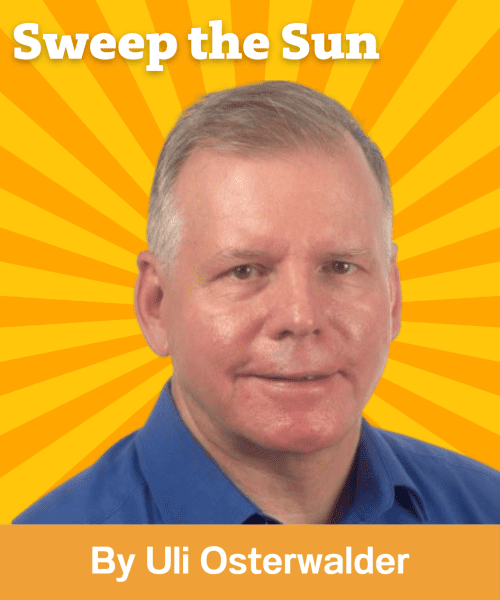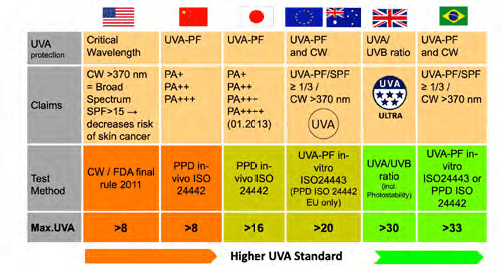
The festive season around the turn of the year is the time of wishes and resolutions. So, this seems to be the right time to ask the question “what is the ideal sun protection”, in other words “what is the optimal protection profile”. I have been asking myself this question since I started working with UV filters in personal care more than 20 years ago. Coming from a fabric care background and having even earlier experience with textile dyes, it was easy for me to come to terms with the idea that the best sun protection is to cover up. As I have expressed in previous issues of this column, the closer the protective profile of the sunscreen is to that of the clothing, i.e., the more uniform the sun protection, the better the sun protection. Brian Diffey suggested uniform sun protection 30 years ago1 and we adopted this strategy in the development of UV filters2. Later, Diffey elaborated on this idea of ideal sun protection and predicted: “Sunscreens and melanoma: the future looks bright”3, 4. He also designed a new metric called “Spectral uniformity: a new index of broad spectrum (UVA) protection”5, but the time was apparently not yet ripe for industry to adopt it.
Perhaps the industry needed some “mathematical” evidence to support the advocacy of this ideal uniform protection, also known as spectral homeostasis protection? Five years ago, Diffey wrote again about optimizing the spectral absorption profile of sunscreens6. This time, he not only argued for uniform protection, but also debunked the myth that we need more UVB protection than UVA protection.
An often-heard argument against uniform protection is that more UVA protection only comes at the expense of less UVB protection. People would say, “I don’t want to compromise on UVB protection” … because “skin cancer is caused by UVB” …
While it may be tempting to believe that higher UVB than higher UVA protection is beneficial, this is a fallacy for several reasons):
- Sunscreens with the same SPF provide the same protection against erythema regardless of whether UVB protection is higher or lower than UVA protection.
- The total UV exposure of sunscreens with a 3:1 ratio between UVB and UVA protection, as expressed in the EU recommendation7, is up to 5 times higher than that of sunscreens with a flat spectral profile
- A 3:1 profile provides lower protection against other action spectra than erythema, e.g. one with higher activity in the UVA range.
The latter statement is particularly true for melanoma prevention, where it now seems clear that UVA plays an important role. Figure 1 shows the monochromatic protection factor (mPF) of a sunscreen with SPF 30 over the entire UV range. We see that the maximum protection at mPF 40 is in the UVB range, but in the long UVA1 range, the protection is only about mPF 10 or less. This is the range where large amounts of UVA radiation can penetrate the sunscreen.
In summary, the spectral protection profile should ideally be flat at all wavelengths throughout the UV spectrum. This philosophy is gaining more and more acceptance, and for several years manufacturers have been working to develop sunscreens with spectral profiles that approach uniform absorption across the entire UV spectrum. Today, there are also already some products that practically meet this criterion of spectral uniformity8, 9. Passeron T et al. recently pointed out that the observed adverse biological effects of UVA1 leading to clinical consequences, combined with the predominance of UVA1 rays in solar UV radiation, provide a solid rationale for the need for broad-spectrum photoprotection that includes UVA1 up to 400 nm10.

An mPF 30 (Figure 1) is actually good enough to protect against UVB in most circumstances, whereas an mPF 10 or less in the long UVA1 range can be harmful, e.g., if a so-called “UVA erythema” develops during a longer exposure. Anecdotal evidence from dermatologists suggests that such UVA erythema caused by UVBskewed sunscreens is much deeper and therefore more severe than ordinary erythema due mainly to UVB11. I am not aware of any studies on this topic, but the recommendation is clear, i.e., choose sunscreens with adequate UVA protection, ideally the “ideal sunscreen with uniform protection”.
The question remains, how can you assess the protection profile? How can I check what my sun protection profile looks like? SPF alone does not tell us enough12. Emerging alternative SPF methods provide this information across the spectrum13.
The various UVA metrics give us a good indication of how close we are to the ideal sunscreen. Figure 2 shows the highest UVA protection requirements in different countries/regions. The simplest and also most instructive approach is to use the available in-silico tools14, 15. Both BASF Sunscreen Simulator and DSM Sunscreen Optimizer provide all UVA metrics commonly used anywhere in the world.

These simulation tools also calculate the extra UV exposure resulting from the fact that most sunscreens do not have ideal protection profiles. The metric used is NTUV dose (normalized transmitted UV). To give an example: The difference in NTUV dose of a SPF 10 sunscreen with the broad-spectrum Filter Zinc Oxide (NTUV = 1.8) and with the UVB filter EthylHexylMethoxyCinnamate (NTUV = 7.2) is 4-fold. This means that 4 times more UV radiation, mainly more UVA, reaches the skin with the latter sunscreen. An ideal sunscreen profile would result in an NTUV dose = 1.0.
Conclusion: do NOT just pay attention to the SPF, a balanced profile is just as important. Just aim for as much UVA protection as possible, and even if you don’t reach the optimal protection profile of the ideal sunscreen right away, it’s still good to know you’re on the right track.
References:
- 1 Diffey, B.L. The need for sunscreens with broad spectrum protection. In: Biological Responses to Ultraviolet A Radiation (Urbach, F., ed.), pp. 321–328. Valdenmar Publishing Company, Overland Park KS (1992).
- 2 Osterwalder U, Herzog B. The long way towards the ideal sunscreen–where we stand and what still needs to be done. Photochem Photobiol Sci. 2010 Apr;9(4):470-81. doi: 10.1039/b9pp00178f. PMID: 20354640
- 3 Diffey BL. Sunscreens and melanoma: the future looks bright. Br J Dermatol. 2005 Aug;153(2):378-81. doi: 10.1111/j.1365-2133.2005.06729.x. PMID: 16086753.
- 4 Diffey BL, Brown MW. The ideal spectral profile of topical sunscreens. Photochem Photobiol. 2012 May-Jun;88(3):744-7. doi: 10.1111/j.1751-1097.2012.01084.x. Epub 2012 Jan 31. PMID: 22233183.
- 5 Diffey B. Spectral uniformity: a new index of broad spectrum (UVA) protection. Int J Cosmet Sci. 2009 Feb;31(1):63-8. doi: 10.1111/j.1468-2494.2008.00471.x. PMID: 19134129.
- 6 Diffey BL. Optimizing the spectral absorption profile of sunscreens. Int J Cosmet Sci. 2017 Feb;39(1):90-doi: 10.1111/ics.12353. Epub 2016 Jul 25. PMID: 27388284.
- 7 COMMISSION RECOMMENDATION of 22 September 2006 on the efficacy of sunscreen products and the claims made relating thereto. Official Journal of the European Union. L 265/39. Available from: https://eur-lex.europa.eu/legalcontent/EN/TXT/PDF/?uri=CELEX:32006H0647&from=CS, viewed October 12,2020
- 8 Osterwalder, U. and Hareng, L. Global UV filters: current technologies and future innovations. In: Principles and Practice of Photoprotection (Wang, S.Q. and Lim, H.W. eds.), pp. 179–198. Springer International Publishing, Switzerland (2016).
- 9 Dudley DK, Laughlin SA, Osterwalder U. Spectral Homeostasis – The Fundamental Requirement for an Ideal Sunscreen. Curr Probl Dermatol. 2021;55:72-92. doi: 10.1159/000517593. Epub 2021 Oct 25. PMID: 34698022
- 10 Bernerd F, Passeron T, Castiel I, Marionnet C. The Damaging Effects of Long UVA (UVA1) Rays: A Major Challenge to Preserve Skin Health and Integrity. Int J Mol Sci. 2022 Jul 26;23(15):8243. doi: 10.3390/ijms23158243. PMID: 35897826; PMCID: PMC9368482
- 11 Personal Communication, Sharyn A Laughlin, MD, Ottawa, CAN, 2019
- 12 ISO 24444:2019: Cosmetics – Sun protection test methods – In vivo determination of the sun protectionfactor (SPF). Available from: https://www.iso.org/standard/72250.html, viewed October 12, 2020.
- 13 Surber C, Uhlig S, Bertrand C, Vollhardt J, Osterwalder U. Past, Present, and Future of Sun Protection Metrics. Curr Probl Dermatol. 2021;55:170-187. doi: 10.1159/000517667
- 14 BASF Sunscreen-Simulator. Available from: https://www.sunscreensimulator. basf.com/Sunscreen_Simulator/login, viewed September 30, 2020
- 15 DSM SUNSCREEN OPTIMIZER. Available from: https://www.sunscreenoptimizer.com/index.html?sid=9bdaee5622fecd3909de24ea4236f74c, viewed September 30, 2020

Uli Osterwalder
Uli Osterwalder studied Chemical Engineering at ETH Zurich, Switzerland and at the University of Houston in Houston, Texas. He joined Ciba-Geigy in Basel in 1979 where he first developed a Phosgene Generator in central process development. Later he developed his leadership skills in Project Management and Process Analytics. At Ciba Specialty Chemicals Uli Osterwalder helped establish new business development in Fabric Care and Personal Care. After the acquisition by BASF SE he became Senior Marketing Manager and Scientific Adviser in Sun Care in Ludwigshafen and Duesseldorf.
2016 he came back to Basel, working for DSM as senior Senior Scientific Adviser suncare for two years. 2018 he started his own company, Sun Protection Facilitator GmbH and is committed to contribute to further improvements in sun protection. Uli Osterwalder works for ISO on the development of new UV protection assessment methods and is now chairing the technical committee ISO TC/217 (Cosmetics). He is author and co-author of numerous scientific articles and book chapters on sun protection.



